Servicios Personalizados
Revista
Articulo
Indicadores
-
 Citado por SciELO
Citado por SciELO -
 Accesos
Accesos
Links relacionados
-
 Citado por Google
Citado por Google -
 Similares en
SciELO
Similares en
SciELO -
 Similares en Google
Similares en Google
Compartir
Revista Latinoamericana de Psicología
versión impresa ISSN 0120-0534
rev.latinoam.psicol. vol.45 no.1 Bogotá ene./abr. 2013
Magnitude and valence of outcomes as determinants of causal judgments
Magnitud y valencia de las consecuencias como determinantes de la atribución de juicios causales
Diana Delgado
Fundación Universitaria Konrad Lorenz, Colombia
Correspondence concerning this paper should be sent to: Diana Marcela Delgado, Human Behavior Research Laboratory Fundación Universitaria Konrad Lorenz, University Foundation Konrad Lorenz. diana.delgado@konradlorenz.edu.co
Recibido: Septiembre de 2012 Revisado: Diciembre de 2012 Aceptado: Abril de 2013
Abstract
This study examines if the blocking effect paradigm predicts causal judgments when consequences of events vary in valence and magnitude. The procedure consists on presenting participants with reports describing the positive or negative effects produced by different substances, when these are consumed either separately or simultaneously with others. Two groups of participants were exposed to high and low magnitude consequences, respectively. The extent to which behavior with respect to causal judgments is consistent with the predictions of the blocking effect was evaluated in in both groups using two types of questions. One of them asked whether or not substance X produced the effect, while the other one asked about the probability of substance X producing the effect. Differences in causal judgments as a product of logical or intuitive reasoning were examined. Even though the blocking effect was not observed, a significant interaction was obtained between the factors valence and experimental condition (blocking and control). Findings are discussed in terms of the differences between associative learning in humans and in non-human animals, and in terms of the theoretical differences between evaluative conditioning and predictive or causal conditioning.
Key words: causal judgments, blocking effect, associative learning, logical reasoning, intuitive reasoning, evaluative conditioning, predictive conditioning.
Resumen
El propósito de este proyecto es examinar si el modelo de bloqueo predice la atribución de juicios causales al variar la valencia y la magnitud de las consecuencias. El arreglo experimental consiste en la presentación de reportes sobre los efectos positivos y negativos que producen diferentes sustancias al ser consumidas solas o en conjunto con otras. Los participantes del primer grupo estuvieron expuestos a consecuencias de alta magnitud y los del segundo grupo, a consecuencias de baja magnitud. Se evaluó si la atribución de causalidad es consistente con las predicciones del efecto bloqueo mediante dos tipos de pregunta: una pregunta acerca si la sustancia X produce o no el efecto, y una pregunta sobre la probabilidad de que X produzca el efecto. Se examinaron las diferencias en los juicios causales cuando las atribuciones son producto del razonamiento lógico o intuitivo. Si bien no se observó evidencia del efecto bloqueo, se obtuvieron efectos de interacción entre los factores valencia y condición experimental (sustancias bloqueo y control). Se discuten los hallazgos en términos de las diferencias entre el aprendizaje asociativo en humanos y animales no humanos, y en términos de las implicaciones sobre las diferencias teóricas entre el condicionamiento evaluativo y el condicionamiento predictivo.
Palabras clave: juicios causales, bloqueo, aprendizaje asociativo, razonamiento lógico, razonamiento intuitivo, condicionamiento evaluativo, condicionamiento predictivo.
Recent developments in the study of human learning from a classical conditioning paradigm are focusing in the use of traditional experimental procedures to study complex human behavior (Walther, Nagengast & Trasselli, 2005; Rescorla, 1988). The blocking effect for example, has been examined in studies of perceptual responding (Arcediano, Matute & Miller, 1997), spatial orientation (Wilson & Alexander, 2008), the acquisition of reading and writing repertories (Didden, Prinsen & Sigafoos, 2000; Singh & Solman, 1990), stimulus class acquisition (Delgado & Medina, In press; Rehfeldt, Dixon, Hayes & Steele, 1998), and causal learning (see Shanks, 2010 for a review).
The purpose of this study is to identify the conditions under which people make causality judgments in an ambiguous situation where an event may have two possible causes. In contrast to animal studies, experimental findings of the blocking effect in humans have not been as consistent (Livesey & Boakes, 2004). While some authors contend that the blocking effect accurately predict instances of human behavior (Crookes & Moran, 2003, Kruschke, Kapperman & Hetrick, 2005), others question that view (Beckers, de Vicq, & Baeyens, 2009; Delgado & Medina, in press; Laane, Aru & Dickinson, 2010; Rehfeldt, et al., 1998). In the case of experiments on casual learning research, the latter authors argue that when participants are exposed to a circumstance in which a consequence is produced by events A and AX (A+, AX+), attributions of causality to X have not been systematically observed.
Traditional explanations describe that the blocking effect occurs because due to the history of associations between A and the US (unconditioned stimulus), stimulus A acquires all the associative strength of the US, making X redundant during AX+ presentations (Kamin, 1969). Even though other theories of the blocking effect have been proposed (e.g., Blaisdell, Gunther, & Miller, 1999; Mackintosh, 1975; Pearce & Hall, 1980), the circumstances responsible for the attenuation of responding to the target stimulus remain a subject of current investigation in human research (see De Houwer, 2009; De Houwer & Beckers, 2002; Shanks, 2010).
According to one of the dominant explanations for the inconsistent findings of the blocking effect in humans, responding to the target stimulus is influenced by the way in which participants process compound stimuli. (Glautier, 2002, 2008; Livesey & Boakes, 2004; Williams, Sagness & McPhee, 1994). When stimuli are processed configurally participants respond to compound stimulus as a single stimulus event without discriminating its elements in terms of their function. By contrast, in elemental processing each of the elements of the compound acquire the functions of US independently (Glautier, 2002, 2008; Williams, Sagness & McPhee, 1994).
Experimental procedures in human causal learning have compared ratings of causality judgments of the target stimulus when participants are exposed to preparations facilitating either configural or elemental responding. The most commonly used procedures include: facilitating elemental approaches by specifying an additive effect, as in A+ and AX++ (Beckers, De Houwer, Pineno & Miller, 2005; De Houwer, Beckers & Glautier, 2002; Livesey & Boakes, 2004; Lovibond, Been, Mitchell, Bouton, & Frohardt, 2003); increasing the spatial separation of both of the stimuli in the compound, i.e., target and competitor (Glautier, 2002), and exposing participants to pre-trainings favoring either elemental or configural responding (De Houwer & Beckers, 2003). Findings from these studies have shown consistently that the blocking effect is generally predicted by elemental approaches only. According to these authors, if AX is perceived configurally, A+ will have no effect on subsequent AX+ pairings and therefore, X will not be redundant in the prediction of the consequence.
Another factor that may account for the variability of findings in studies of the blocking effect in humans is the type of reasoning used to emit a causality judgment. Several authors support the idea that human causal learning studies involve logical and deliberate processes that cannot be sufficiently described by contingency learning approaches (De Houwer, Beckers & Vandorpe, 2005; De Houwer & Vandorpe, 2010; Karazinov & Boakes, 2007; Vandorpe & De Houwer, 2006; Vandorpe, De Houwer & Beckers, 2005; Walther, 2002; Walther, Nagengast & Trasselli, 2005).
In this respect, it is argued that logical reasoning involves evaluating the likelihood of a consequence according to the available information. For example Vandorpe and De Houwer (2006), reported a lower blocking effect in human causality judgments when A and AX occurred with maximal intensity. By contrast, when target and competitor where presented with submaximal intensity blocking was more frequently observed. In addition, a larger number of participants reported an interest in obtaining more information about the effects of X, when A+ and AX+ were presented with maximal intensity. According to these findings it may be easier to conclude that X does not contribute to the outcome when A and AX occur with submaximal intensity. By contrast, when outcomes are presented with maximal intensity the information about A and AX in relation to the outcome is insufficient to produce a reliable judgment as to the causal function of X (see also Beckers et al, 2005; De Houwer & Beckers, 2003; De Houwer et al, 2002; Vandorpe et al, 2005).
In addition, studies in evaluative conditioning and second order conditioning, show higher conditioning effects, or results that differ from what is expected from the conditioning procedure used, when the experimental preparation includes a task that interferes with deliberate reasoning. (Karazinov & Boakes, 2007; Walther, 2002). Nonetheless, the view that human causal learning cannot be sufficiently described by the principles of associative learning remains a subject of controversy (Beckers, Miller, De Houwer, & Urushihara, 2006; Beckers et al, 2005).
Additional factors that may influence attribution of causality judgments are characteristics of the consequences such as their intensity and their positive or negative valence. For example, some animal experiments suggest that greater intensity outcomes may be associated with increased cue competition effects (i.e., more blocking). Specifically, it has been reported that learning occurs more rapidly and regardless of increments to the CS-US interval, when stimuli of high biological significance are used. (Domjan, Cusato & Krause, 2004). Given the undefined relevance of the conventional and/or arbitrary stimuli used in studies with humans (e.g., operant equivalence studies), less cue competition effects (higher probability of conditioning of A and X) may be expected. However, a study by Denniston, Miller and Matute (1996) provides evidence to the contrary; that is, the authors suggest that higher biological significance protects against cue competition effects such as blocking and overshadowing (see also Oberling, Bristol, Matute & Miller, 2000).
On the other hand, evaluative conditioning studies have examined conditioning processes when outcomes of positive or negative valence are used. Results from these studies have shown that unlike traditional associative conditioning, evaluative conditioning does not require contingency awareness (Jones, Fazio & Olson, 2009; Walther, 2002, Walther & Nagengast, 2006), is highly resistant to extinction (Baeyens, Days & Ruiz, 2005), and may be insensitive to cue competition effects (Beckers et al, 2009). Although these findings support the view that Pavlovian and evaluative learning constitute different types of learning processes (see Baeyens et al 2005; Walther, 2002) this distinction has remained controversial for over a decade (Field, 2000).
In spite of the lack of sufficient empirical data examining the differential effects of consequences of positive and negative valence on causal attributions, the studies reviewed above suggest that higher magnitude consequences and consequences rated as aversive, may be associated with lower attributions of causality to the target stimulus (e.g., greater blocking effect).
In the present study, participants observed a series of pharmacological reports describing the consequences of consuming one or two combined substances. The sample was divided in two groups. One group was presented with high magnitude consequences and the other, with low magnitude consequences only. Substances with positive and negative consequences were presented to both groups. In contrast with most human causal learning studies, in addition to reporting probability ratings about the causal function of the stimuli, we report whether or not the participants would be willing to consume the target substance. Therefore, causal attributions are examined using two types of measures. The first one is intended to provide logical and deliberate responses and; the second one, attempts to produce causal attributions prompted by a context in which intuitive reasoning is more likely (see García-Retamero & Dieckman, 2006; Todd & Gigerenzer, 2000).
Generally, above-criterion ratings of causality are considered as indicators of causal attribution to each of the stimuli evaluated. However, results from a pilot study conducted in our lab showed that participants reporting a 0.5 probability that a substance will produce an effect, may also report that this substance will cause the effect, when presented with a Yes or No question. By including both types of questions we explore the possible differences in causal attributions when responses of the intuitive and deliberate sorts are induced.
Method
The purpose of this experiment was to examine the possible differences in causality judgments when the outcome of an ambiguous situation (blocking effect procedure) is either of high magnitude, or low magnitude, and when it is positive or negative valued. Effect magnitude was evaluated between groups and stimulus valence was evaluated within groups.
The experiment presented participants with reports of a pharmaceutical laboratory describing the consequences of consuming different types of substances. Substances with positive consequences presented during the first phase of the blocking procedure were A+, B+, C- and D-, and substances included in the second phase were AE+, HI+ and JK-. Substance E corresponded to the target stimulus, substance A to the competitor, HI was the control stimulus, and B, C, D and JK were used as fillers. Substances with negative consequences were designated with numbers as follows: the first training phase included stimuli 1+, 2-, 3+ and 4- and the second phase included stimuli 15+, 67+ and 89-. Substance 5 was the target stimulus, substance 1 the competitor, substances 67+ were the controls, and substances 2, 3, 4, and 89 were included as fillers. The "+" sign in front of each letter or number indicates the occurrence of a consequence following the consumption of a substance, and the sign "-" indicates the absence of a consequence following the consumption of a substance.
Participants
The participants were 62 college students ranging from 18 to 29 years of age. All participants agreed to participate in the study for course credit benefits, and signed informed consent. Participants were assigned to each of the groups (high and low magnitude) by order of arrival.
Instruments
The experimental tasks were presented in desktop computers (17 inches monitors) located in individual workstations. All the experimental tasks were programmed in the software LabView v. 2011.
Procedure
Consequence selection (Pre-experimental phase): All the events to be used as consequences were selected prior to the design and programming of the experimental task. Twenty college students rated 15 positive and negative statements of high and low magnitude in a 1 to 5 Likert scale. Statements with average ratings above 4 and below 2 were pre-selected and finally the statements with the highest and lowest scores were selected for the study. The consequences selected for each group are shown in Table 1.
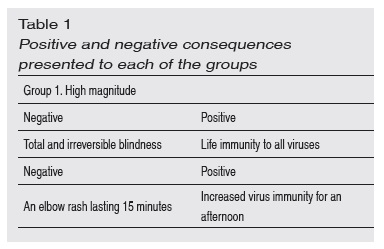
Training Phase 1: At the beginning the experimental task, the following instructions were presented on the computer screen: "You are currently working for a pharmaceutical laboratory. Your job is to review some of the clinical records describing the effects of different types of substances in a population sample. You will note that in some cases substances were consumed individually while in some others, two substances were consumed in combination. Based on the information provided on these records, you will be asked to answer a couple of questions. Your answers will help the pharmaceutical company establish the effectiveness of each of these substances".
During the first training phase participants were exposed to 3 A+, B+, C- and D-trials in which substances were associated to positive consequences, and to 3 1+, 2-, 3+ y 4 trials in which substances were presented with negative consequences. The stimuli in all 12 trials were presented in semi-random order. Each trial consisted on the presentation of a statement describing the effect of consuming a particular substance. For A+ trials for example, the following statement was presented: "People who have consumed substance A become immune to all viruses for life". In front of this statement an illustration of the lab report was presented. The illustration showed a container labeled "Substance A" with a brief description of the observed effect printed below. There was no time limit for each trial. The next trial began when the participant clicked on a button labeled "continue".
After this first training phase was completed, a filter test evaluated acquisition of the previously trained relations. Four containers corresponding to the 4 substances presented during the first training phase were shown on the top half of the computer screen. Two blank squares were presented below. One of them was labeled "produces the effect" and the other one was labeled "does not produce the effect". Participants were asked to drag the containers into the correct square according to whether the substance in the container produced an effect or not. One incorrect classification reset the presentation of all training trials and of the sorting test; and two incorrect classifications ended the experiment. A correct classification of the four substances was followed by the presentation of the second training phase.
Training Phase 2: During the second phase participants were exposed to AE+ HI+ and JK- pairings of substances and their positive consequences. Associations of substances with negative consequences included 15+, 67+ and 89-pairings. As in the first training phase, each compound stimulus and its effect was presented semi-randomly 3 times, for a total of 9 trials for each set of substances. The format of presentation of substances and consequences in each trial was the same as the one described for the first training phase. After all the 9 training trials were completed, the first evaluation of causality judgments was presented.
Test 1. Intuitive Reasoning: For this test, containers corresponding to the 9 substances presented previously in the two training phases were arranged evenly in 3 rows and columns. An instruction asked participants to answer whether or not they would drink from each of the containers shown on the screen. Answers were recorded by clicking on one of the two boxes in front of each container labeled Yes and No. All answers were required to continue with the next phase of the experiment.
Test 2. Logical reasoning: The logical reasoning test consisted of 9 trials. In each trial, participants were asked to indicate the probability of a consequence after consuming each of the substances separately. Participants were instructed to indicate their answer on a 0 to100 scale presented below each question.
Table 2 below, shows the order of presentation of all training and testing phases and the associations presented in each phase. As this table shows, participants were first exposed to all training and testing phases with substances and their positive effects. Following this, the same sequence of training and testing was presented for substances with negative effects. Participants in both groups (high and low magnitude) were exposed to the same experimental setup.

Results
A (2 x 2 x 2) mixed between-within subjects ANOVA was conducted with magnitude (high and low) as the between subjects factor, and valence of the consequences (positive and negative) and experimental condition (target and control stimuli) as within subjects factors. The analysis of variance did not show main effects for valence, magnitude, or experimental condition. Table 3 presents mean ratings observed for each of the factors included in the analysis.
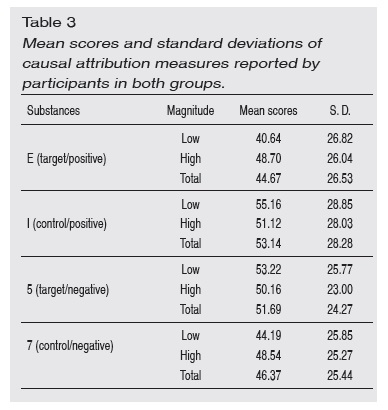
As Table 3 shows, none of the substances were rated with probabilities of producing the effect higher than 55% in average. Contrary to the predictions of the blocking effect, no significant differences between causality ratings for target and control substances were observed. However, a significant interaction effect between valence (positive - negative) and experimental condition (target - control) was obtained, with F (1, 60) = 4.41, p = 0.04, and partial η2 = 0.06. Table 4 presents the means obtained for the interaction valence x experimental condition.
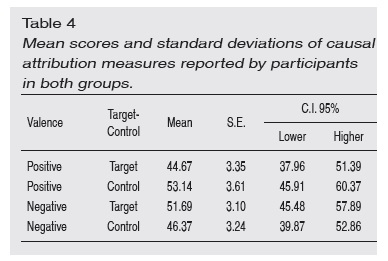
The target substance was rated lower on the causal probability scale than the control substance but only when the effects of consuming these substances were positive. The opposite effect was observed for causal attributions scores to substances with negative effects. Even though the difference between scores for target and control stimuli does not exceed 9 percentage points, it is consistent with the blocking effect in that lower causality ratings were observed for the target stimulus. However this is the case for target and control stimuli with positive consequences only. (see Figure 1). Note though that probability ratings for all the stimuli included in this analysis were not higher than 53%.
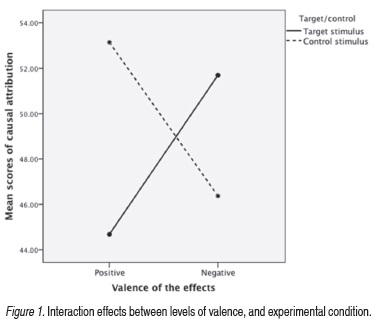
In contrast with this results, mean scores of causal attribution for all other stimuli/substances not included in the ANOVA, were much higher than those observed for target and control stimuli. While mean scores for substances E (target/positive), I (control/positive), 5 (target/ negative) and 7 (control/negative), range between 44 and 53%, average scores for all other substances (competitor stimulus A and filler B / for positive valence stimuli, and competitor stimulus 1 and filler 6 for negative valence stimuli) range between 66 and 80% (see Table 5).

Note though that substances H and 6 (which are part of control stimuli HI and 67) were rated similarly than substances I and 7 included in the analysis of variance. That is, participants attributed approximately a 50% probability that each separate element of the compound produced the effect. The elements of the AE and 15 compounds also presented during the second training phase were rated quite differently though. While a probability rating close to 50% was attributed to target stimuli E and 5, their corresponding competitors (presented alone with the consequence during training phase 1) obtained the highest causal attribution scores.
Attributions of causality based on Yes or No answers to the intuitive reasoning question were also examined. Table 6 shows the percentage of participants in each group (high and low magnitude) who attributed causality to each substance (responded Yes to the intuitive reasoning question). These data show clear differences between groups of high and low magnitude with respect to their causality judgments. While most of the participants in the low magnitude group attributed causality to each one of the substances, less than 39% of the participants in the high magnitude group did.
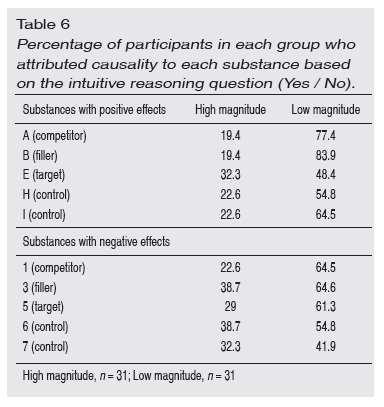
Finally, in order to contrast the degree of coincidence between causality judgments based on answers to the logical reasoning question (scores on the probability scale), and those based on answers to the intuitive reasoning question (yes/no answers), we examined the scores reported by participants who answered yes or no to the intuitive reasoning question about the causality of each substance. To facilitate data inspection, causality ratings were divided in 4 equal groups: the first group includes ratings from 0 to 25%, the second group includes ratings from 26 to 50%, the third group includes ratings from 51 to 75% and the last group includes scores from 76 to 100%. Data for participants in high and low magnitude groups are shown in Tables 7 and 8 respectively.
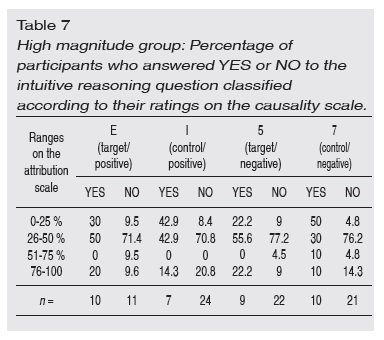
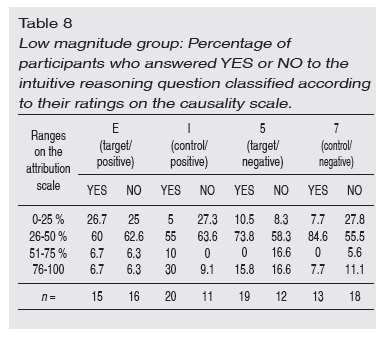
Most of the participants in the high magnitude group did not attribute causality to any of the substances based on the reports to the intuitive reasoning question (see Table 6). In addition, most of the participants who answered yes and no to the intuitive reasoning question reported probability scores lower than 50%. The same was observed for the low magnitude group. In general, the data shown in Tables 7 and 8 do not seem consistent with the predictions of the blocking effect. The number of participants who did not attribute causality to target substances E and 5 was not higher than the number of participants who attributed causality to control substances I and 7.
Discussion
The purpose of this study was to analyze the effects of two properties of the consequences on human causality judgments. Specifically the effects of the positive or negative valence of the consequences, and the effect of high and low magnitude consequences on attributions of causality were examined using a blocking procedure. According to some authors some of the inconsistencies in the observation of the blocking effect in humans are due to the fact that the blocking procedure constitutes an ambiguous situation with respect to cause-consequence relations (Beckers et al, 2005; Vandorpe & De Houwer, 2006; Vandorpe et al, 2005). The present study evaluated the blocking effect in a human causal learning preparation including consequences with a positive or negative affective value, and consequences of high and low magnitude.
The occurrence of the blocking effect was evaluated using two measures of causal attribution. In one of them participants reported on a 0 to 100 scale the probability that consuming each substance separately would produce an effect. In the other, participants reported whether or not they would be willing to drink each of the substances separately. The first report was interpreted to be the result of logical reasoning and the second, was interpreted as a product of intuitive reasoning (see García-Retamero & Dieckmann, 2006; Tversy & Kahneman, 1974).
Additionally, because the traditional blocking procedure includes a control condition (i.e., presenting a compound stimuli with elements that have not been associated previously with the outcome), our analysis included a comparison between the causal attribution ratings of target and control stimuli.
Although main effects for magnitude, valence or experimental condition (target or control stimuli) were not observed, a significant interaction effect between valence and experimental condition was obtained. This interaction effect was consistent with the predictions of the blocking effect but only for substances with positive consequences. Lower scores of causal attribution were reported for the target positive substance (E) than for the control substance (I) in the HI control compound. However, the opposite relation between target and control stimuli was observed for substances with negative outcomes.
Apparently negative consequences may be associated with a higher likelihood of transfer of outcome functions to the target stimulus. Because these functions are acquired by the competitor stimulus during the first training phase of the blocking procedure, they may be transferred to the target stimulus due to the contiguous presentations of target and competitor. In contrast, increased cue competition was observed for substances with positive consequences Once substance A acquires some of the functions of the outcome during the first training phase, substance E cannot further contribute to the prediction of the outcome. As a result lower causality scores are attributed to the target substance than to competitor and control substances.
It is important to clarify though that the blocking effect was not observed in either case. By saying that the results observed for positive substances were consistent with the predictions of the blocking effect, we simply mean that causality scores for the target substance where lower than those for the control substance. Mean scores for these substances varied within a very small range with a minimum of 45% and a maximum of 53%. A non very conservative criterion of 30% or lower on the attribution scale for the target stimuli, in addition to higher than 50% ratings for competitor and control stimuli, were considered indicative of the blocking effect. Contrary to expectations however, extreme scores on the attribution scale were not observed. This is further evidenced by the low effect size obtained for the significant interaction effect between valence of the consequences and experimental condition.
Causality scores of around 50% suggest that the information provided regarding cause-consequence relations is insufficient to attribute a higher or lower probability rating for the stimuli evaluated. These findings support the claim that some of the inconsistencies with respect to the occurrence of the blocking effect in humans may be related to the interference of deliberate reasoning about the contingencies to which participants are exposed (De Houwer & Vandorpe, 2010; Karazinov & Boakes, 2007; Walther, 2002; Walther et al, 2005).
On the other hand all competitors (substance A for the group of substances with positive consequences and substance 1 for the group of substances with negative consequences), were attributed the highest causality ratings with mean scores of 75% and above. In contrast, each of the elements of control stimuli HI and 67, were rated with mean scores of approximately 50%. These data suggest that the information available may not be sufficient to determine with a high degree of certainty if each of the substances of the compound stimuli is responsible for the effect.
On the other hand, asking participants if they were willing to consume each of the substances separately was intended to prompt causality judgments based on intuitive reasoning; that is, in the absence of a logical analysis of the probabilities involved. These causality judgments show notable differences between the high and low magnitude groups. A higher percentage of participants in the low magnitude group attributed causality to all substances. A lower percentage of participants attributed causality to target and control substances compared to the percentage of participants who attributed causality to the remaining substances (competitors and fillers). However, because a higher number of participants who did not attribute causality to the target stimuli was not observed (compared to attributions of causality to control stimuli), a blocking effect for these data cannot be concluded either. The examination of attribution scores reported by participants who answered yes or no to the intuitive reasoning question shows that the majority of participants reported probabilities that an effect will be produced by a substance between 25 and 50% regardless of whether they attributed causality to the substance or not (answered yes or no).
Asking participants whether or not each substance produces the effect, rather than asking whether or not they would consume the substance could have been a more objective measure of causal attribution. Answers to the latter question may reflect the participants' interest/disinterest in the hypothetical effect produced by the substances rather than their causal judgments. However, the question used was preferred to a more direct one because involving the participants in the hypothetical situation was considered a good prompt for responses based on intuitive reasoning. The question as it was formulated, however, may have introduced an uncontrolled source of variability.
Future research could examine the effect of outcome valence on causal attribution ratings, when outcomes are presented at submaximal values. Several studies have shown that this manipulation provides participants with the necessary information to determine the contribution of each of the elements of a compound in the production of a consequence, thus increasing the probability of observing a blocking effect (Beckers et al, 2005; De Houwer & Beckers, 2003; De Houwer et al, 2002; Vandorpe et al, 2005). After controlling for the variability produced by the different ways in which individuals respond to compound stimuli (configurally or elementally), a more accurate assessment of the effect of outcome valence and magnitude on causal attribution ratings, could be achieved.
A procedural variation that would be interesting to explore consists of describing cause and consequence relations in a single trial description (resumed procedure) as opposed to exposing participants to a history of stimulus pairings. While the latter procedure has been useful for studying learning processes in non-human animals and non-verbal individuals, the study of human learning processes may benefit from the use of procedures with higher ecological validity (see, e.g., García-Retamero, Ramos & Catena, 2008). Researchers in our lab are currently replicating the experiment presented here using a resumed procedure.
The present study examined relations of causality with an added component from the evaluative conditioning literature, namely, the valence of the consequences. Our findings are consistent with those of a recent study showing that evaluative conditioning may be insensitive to the blocking effect (Beckers et al, 2009). However, the view that evaluative conditioning and Pavlovian conditioning constitute different types of learning processes (see Bar-Anan, De Houwer, & Nosek, 2010) needs further empirical and theoretical support. Similarly, additional empirical evidence is also required to determine if the principles of associative learning are sufficient to describe and explain complex human behavior or if different explanatory models are required.
References
Arcediano, F., Matute, H., & Miller, R.R. (1997). Blocking of Pavlovian conditioning in humans. Learning and Motivation, 28, 188-199. [ Links ]
Baeyens, F., Díaz, E., & Ruíz, G. (2005). Resistance to extinction of human evaluative conditioning using a between-subject design. Cognition and Emotion, 19(2), 245-268. doi: 10.1080/02699930441000300. [ Links ]
Bar-Anan, Y., De Houwer, J., & Nosek, B. (2010). Evaluative conditioning and conscious knowledge of contingencies: A correlational investigation with large samples. Quarterly Journal of Experimental Psychology, 63, 2313-2335. [ Links ]
Beckers, T., De Houwer, J., Pineno, O., & Miller, R. R. (2005). Outcome additivity and outcome maximality influence cue competition in human causal learning. Journal of Experimental Psychology: Learning, Memory, & Cognition, 31, 238-249. doi: 10.1037/0278-7393.31.2.238 [ Links ]
Beckers, T., de Vicq, P., & Baeyens, F. (2009). Evaluative conditioning is insensitive to blocking. Psychologica Belgica, 49, 41-57. [ Links ]
Beckers, T., Miller, R. R., De Houwer, J., & Urushihara, K. (2006). Reasoning rats: Forward blocking in Pavlovian animal conditioning is sensitive to constraints of causal inference. Journal of Experimental Psychology: General, 135, 92-102. 10.1037/0096-3445.135.1.92 [ Links ]
Beckers, T., Van den Broeck, U., Renne, M., Vandorpe, S., De Houwer, J., & Eelen, P. (2005). Blocking Is Sensitive to Causal Structure in 4-Year-Old and 8-Year-Old Children. Experimental Psychology, 52, 264-271. [ Links ]
Blaisdell, A. P., Gunther, L. G., & Miller, R. R. (1999). Recovery from blocking achieved by extinguishing the blocking CS. Animal Learning & Behavior, 27, 63-76. [ Links ]
Crookes A. E. & Moran P. M. (2003). An investigation into age and gender differences in human Kamin Blocking using a computerised task. Developmental Neuropsychology 24(1), 39-55. [ Links ]
De Houwer, J. (2009). The propositional approach to associative learning as an alternative for association formation models. Learning & Behavior, 37, 1-20. [ Links ]
De Houwer, J., & Beckers, T. (2002). A review of recent developments in research and theory on human contingency learning. Quarterly Journal of Experimental Psychology, 55B, 289-310. doi:10.1080/02724990244000034. [ Links ]
De Houwer, J. & Beckers, T. (2003). Secondary task difficulty modulates forward blocking in human contingency learning. The Quarterly Journal of Experimental Psychology Section B: Comparative and Physiological Psychology, 56(4), 345-357. doi: 10.1080/02724990244000296. [ Links ]
De Houwer, J., Beckers, T., & Glautier, S. (2002). Outcome and cue properties modulate blocking. Quarterly Journal of Experimental Psychology, 55, 965-985. doi: 10.1080/02724980143000578. [ Links ]
De Houwer, J., Beckers, T., & Vandorpe, S. (2005). Evidence for the role of higher-order reasoning processes in cue competition and other learning phenomena. Learning & Behavior, 33, 239-249. [ Links ]
De Houwer, J. & Vandorpe, S. (2010). Using the Implicit Association Test as a measure of causal learning does not eliminate rule learning. Experimental Psychology, 57(1), 67-7. doi: 10.1027/1618-3169/a000008. [ Links ]
Delgado, D., & Medina, I. F. (en prensa). Cuando la contigüidad no es suficiente: Bloqueo en relaciones de equivalencia. Universitas Psychologica, 12(2). [ Links ]
Denniston, J. C., Miller, R. R., & Matute, H. (1996). Biological significance as a determinant of cue competition. Psychological Science, 7(6), 325-331. doi: 10.1111/j.1467-9280.1996.tb00383. [ Links ]
Didden, R., Prinsen, H., & Sigafoos, J. (2000). The blocking effect of pictorial prompts on sight-word reading. Journal of Applied Behavior Analysis, 33, 317-320. [ Links ]
Domjan, M., Cusato, B., & Krause, M. (2004). Learning with arbitrary versus ecological conditioned stimuli: Evidence from sexual conditioning. Psychonomic Bulletin and Review, 11, 232-246. doi: 10.3758/ BF03196565. [ Links ]
Field, A. P. (2000). I like it, but I'm not sure why: Can evaluative conditioning occur without conscious awareness? Consciousness and Cognition, 9, 13-36. [ Links ]
García-Retamero, R., & Dieckmann, A. (2006). Una visión crítica del enfoque de los heurísticos rápidos y frugales. Revista Latinoamericana de Psicología, 38(3), 509-522. [ Links ]
García-Retamero, R., Ramos, M., & Catena, A. (2008). El procesamiento de compuestos estimulares en juicios de causalidad. Revista Latinoamericana de Psicología, 40(1), 21-34 [ Links ]
Glautier, S. (2002). Spatial separation of target and competitor cues enhances blocking of human causality judgements. The Quarterly Journal of Experimental Psychology, 55B, 121-135. [ Links ]
Glautier, S. (2008). The elemental-configural distinction: a problem of two dimensions: commentary on Melchers, Shanks, and Lachnit. Behavioural Processes, 77, 431-433. doi: 10.1016/j.beproc.2007.09.009. [ Links ]
Jones, C. R., Fazio, R. H., & Olson, M. A. (2009). Implicit misattribution as a mechanism underlying evaluative conditioning. Journal of Personality and Social Psychology, 96, 933-948. [ Links ]
Kamin, L. J. (1969). Predictability, surprise, attention, and conditioning. En B. A. Campbell y R. M. Church (Eds.), Punishment and Aversive Behavior (pp. 279-296). New York: Appleton-Century-Crofts. [ Links ]
Karazinov, D. M. & Boakes, R. A. (2007). Second order conditioning in human predictive judgements when there is little time to think. Quarterly Journal of Experimental Psychology, 60, 448-60. doi:10.1080/17470210601002488. [ Links ]
Kruschke, J. K., Kapperman, E. S., & Hetrick, W. P. (2005). Eye gaze and individual differences consistent with learned attention and associative blocking and highlighting. Journal of Experimental Psychology: Learning, Memory & Cognition, 31(5), 830-845. [ Links ]
Laane, K., Aru, J., & Dickinson, A. (2010). Non-competitive liking for brands. No blocking in evaluative conditioning. Appetite, 54(1), 100-107. [ Links ]
Livesey, E. J., & Boakes, R. A. (2004). Outcome additivity, elemental processing and blocking in human causality judgments. The Quarterly Journal of Experimental Psychology, 57B(4), 361-379. [ Links ]
Lovibond, P. F., Been, S. L., Mitchell, C. J., Bouton, M. E., & Frohardt, R. (2003). Forward and backward blocking of causal judgment is enhanced by additivity of effect magnitude. Memory & Cognition, 31, 133-142. doi:10.3758/BF03196088. [ Links ]
Mackintosh, N. J. (1975). A theory of attention: Variations in the associability of stimuli with reinforcement. Psychological Review, 82, 276-298. [ Links ]
Oberling, P., Bristol, A. S., Matute, H., & Miller, R. R. (2000). Biological significance attenuates overshadowing, relative validity, and degraded contingency effects. Animal Learning & Behavior, 28(2), 172-186. [ Links ]
Pearce J.M. & Hall G. (1980) A model for Pavlovian learning: Variations in the effectiveness of conditioned but not of unconditioned stimuli. Psychological Review, 87, 532-552. [ Links ]
Shanks, D. R. (2010). Learning: From Association to Cognition. Annual Review of Psychology, 61, 273-301. doi: 10.1146/annurev.psych.093008.100519. [ Links ]
Singh, N., & Solman, R. (1990). A stimulus control analysis of the picture-word problem in children who are mentally retarded: The blocking effect. Journal of Applied Behavior Analysis, 23, 525-532. [ Links ]
Tversky, A. & Kahneman, D. (1974). Judgments under uncertainty: Heuristics and biases. Science, 185, 1124-1131. [ Links ]
Todd, P. M. & Gigerenzer, G. (2000). Précis of simple heuristics that make us smart. Behavioral & Brain Sciences, 23, 727-780. [ Links ]
Rehfeldt, R. A., Dixon, M. R., Hayes, L. J., & Steele, A. (1998). Stimulus equivalence and the blocking effect. The Psychological Record, 48, 647-664. [ Links ]
Rescorla, R. A. (1988). Pavlovian conditioning is not what you think it is. American Psychologist, 43, 151-160. [ Links ]
Vandorpe, S., & De Houwer, J. (2006). People want to see information that will help them make valid inferences in human causal learning. Memory & Cognition, 34, 1133-1139. doi: 10.3758/BF03193259. [ Links ]
Vandorpe, S., De Houwer, J., & Beckers, T. (2005). Further evidence for the role of inferential reasoning in forward blocking. Memory & Cognition, 33, 1047-1056. [ Links ]
Walther, E. (2002). Guilty by mere association: Evaluative conditioning and the spreading attitude effect. Journal of Personality & Social Psychology, 82, 919-934. [ Links ]
Walther, E., & Nagengast, B. (2006). Evaluative conditioning and the awareness issue: Assessing contingency awareness with the four-picture recognition test. Journal of Experimental Psychology: Animal Behavior Processes, 32, 454-459. [ Links ]
Walther, E., Nagengast, B., & Trasselli, C. (2005). Evaluative conditioning in social psychology: facts and speculations. Cognition and Emotion, 19(2), 175-196. doi: 10.1080/02699930441000274. [ Links ]
Williams, D. A., Sagness, K. E., & McPhee, J. E. (1994). Configural and elemental strategies in predictive learning. Journal of Experimental Psychology: Learning, Memory, and Cognition, 20, 694-709. doi: 10.1037/0278-7393.20.3.694. [ Links ]
Wilson, P. N., & Alexander, T. (2008). Blocking of spatial learning between enclosure geometry and a local landmark. Journal of Experimental Psychology: Learning, Memory & Cognition, 34, 1369-1376. doi: 10.1037/a0013011. [ Links ]













